|
Kamasutra
Art Gallery - 1
|
|
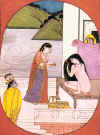 |
Krishna watching Radha at her bath.
Opaque water colour on paper. Garhwal, Panjab hills, c 1800 |
| The late spring festival is celebrated by the
ladies of the Bundi palace while the Maharao and his favourite watch
from the roof. In anticipation of the storms to come, the frangipani
trees are flowering. The pond filled with lotuses, birds and
fish is a typical Bundi motif, as are the flowering trees. The
women wear traditional Rajasthani skirts in the gaudy hand printed
cottons which have recently become popular in the west. Bundi,
c. 1770 |
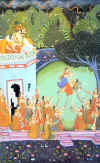 |
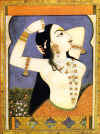 |
A heavily be jewelled lady of the Jaipur
court. She wears rubies, pearls, emeralds, and what might be a
ring of carved jade. Could she be the concubine Ras Kafur,
described by her contemporary, the historian Tod, as a 'common
prostitute, the favourite of the day', to whom Raja Jagat Singh is said
to have given half his wealth? The rose pink city of Jaipur is still
famous for its jewellery, enamel and stone and marbel carving.
Jaipur, c. 1790 |
| Here a perfectly balanced pair of lovers hold
a posture that has elements both of Kaurma and the Yugmapada
of Ratirahasyai, and which may be an intermediate stage
between the two. Achieving balance and with it stillness was especially
important in tantric sexual rites. The painting is
carefully organized to emphasize the theme of passion under control.
Udaipur, late eighteenth century. |
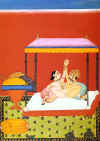 |
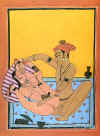 |
The quieting of the violent breath.
'Erotic paintings are far less common in Basohli art than, for instance,
in that of the Rajasthan courts, but this picture, with its startling
shapes and colours, makes brilliant use of Basohli conventions.
The posture is Vyomapada from Ananga Ranga, but the
artist has shown the man using his fingers to control his wife's breath,
and this is almost certainly a depiction of Nadi Sodhana Pranayama (Nerve
cleansing breath control) as adapted for tantric practice.
Basohli, early eighteenth century. |
| The lovers are in an embrace which could be
said to be a sort of reversed Creeper. Above all the artist has tried to
express the tenderness they feel for one another, and the painting is in
the ethereal, lyrical style which originated in the hill states of the
Punjab and the Himalayan foothills. The label Pahari (Mountain
school) indicates simply that we do not know for certain at which court
this rather late work was painted. Pahari, nineteenth century. |
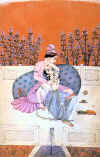 |

